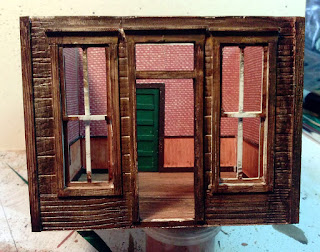Once this stage was complete I let it dry and then applied a coat of matte varnish. Instead of it Vallejo Model Color Matt Varnish through the airbrush this time I opted to spray it with Testors Dullcote from a rattle can. That should protect the weathered paint layer better than the acrylic matte varnish I have been using. I'll let all that dry and hopefully move forward to finish the painting.
 |
| I used some scrap mattboard to help protect the finished interior work |
 |
| On the upper floor I started with the splatter method. Definitely messy |
 |
| On the ground floor I applied ink randomly and then streaked it down with the brush, moving with the grain of the boards. Here Burnt Umber and Carbon Black have been applied. |
 |
| Followed that up with Raw Sienna |
 |
| Straight Burnt Umber |
 |
| Carbon Black and Raw Sienna |
 |
| A fuzzy picture of the front |
 |
| And from the back. |




















































